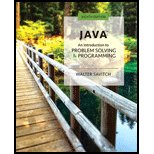
Your country is at war and your enemies are using a secret code to communicate with one another. You have managed to intercept a message that reads as follows:
:mmZ\dxZmx] Zpgy
The message is obviously encrypted using the enemy’s secret code. You have just learned that their encryption method is based upon the ASCII code (see Appendix 7). Individual characters in a string are encoded using this system. For example, the character ‘A’ is encoded using the number 65 and ‘B’ is encoded using the number 66. Your enemy’s secret code takes each letter of the message and encrypts it as follows:
if (OriginalChar + Key > 126) then
EncryptedChar = 32 + ((OriginalChar +Key) − 127)
else
EncryptedChar = (OriginalChar + Key)
For example, if the enemy uses Key = 10 then the message “Hey” would initially be represented as:
Character ASCII code
H 72.
e 101
y 121
And “Hey” would be encrypted as:
Encrypted H − (72 + 10) − 02 − R in ASCII
Encrypted e − (101 + 10) – 111 − o in ASCII
Encrypted y = 32 + ((121 + 10) − 127) = 36 = $ in ASCII
Consequently, “Hey” would be transmitted as “Ro$.” Write a Java program that decrypts the intercepted message. You only know that the key used is a number between 1 and 100. You can assume that the original message consists entirely of ASCII codes that represent only printable characters. Your program should try to decode the message using all possible keys between 1 and 100. When you try the valid key, the message will make sense. For all other keys, the message will appear as gibberish. Since there are only 100 keys this would obviously be a pretty crummy encryption system. This
You will want to use charAt ().
Important: Note that the secret code has a \ so you will need to escape encode it by using \\ if you hard-code it in your program.
Want to see the full answer?
Check out a sample textbook solution
Chapter 4 Solutions
Java: An Introduction to Problem Solving and Programming (8th Edition)
Additional Engineering Textbook Solutions
Introduction To Programming Using Visual Basic (11th Edition)
Mechanics of Materials (10th Edition)
Thinking Like an Engineer: An Active Learning Approach (4th Edition)
Web Development and Design Foundations with HTML5 (8th Edition)
Elementary Surveying: An Introduction To Geomatics (15th Edition)
Starting Out with Programming Logic and Design (5th Edition) (What's New in Computer Science)
- Considering the TM example of binary sum ( see attached)do the step-by-step of execution for the binary numbers 1101 and 11. Feel free to use the Formal Language Editor Tool to execute it; Write it down the current state of the tape (including the head position) and indicate the current state of the TM at each step.arrow_forwardI need help on inculding additonal code where I can can do the opposite code of MatLab, where the function of t that I enter becomes the result of F(t), in other words, turning the time-domain f(t) into the frequency-domain function F(s):arrow_forwardI need help with the TM computation step-by-step execution for the binary numbers 1101 and 11. Formal Language Editor Tool can be used to execute it; Write it down the current state of the tape (including the head position) and indicate the current state of the TM at each step;arrow_forward
 C++ Programming: From Problem Analysis to Program...Computer ScienceISBN:9781337102087Author:D. S. MalikPublisher:Cengage Learning
C++ Programming: From Problem Analysis to Program...Computer ScienceISBN:9781337102087Author:D. S. MalikPublisher:Cengage Learning C++ for Engineers and ScientistsComputer ScienceISBN:9781133187844Author:Bronson, Gary J.Publisher:Course Technology Ptr
C++ for Engineers and ScientistsComputer ScienceISBN:9781133187844Author:Bronson, Gary J.Publisher:Course Technology Ptr Systems ArchitectureComputer ScienceISBN:9781305080195Author:Stephen D. BurdPublisher:Cengage Learning
Systems ArchitectureComputer ScienceISBN:9781305080195Author:Stephen D. BurdPublisher:Cengage Learning EBK JAVA PROGRAMMINGComputer ScienceISBN:9781337671385Author:FARRELLPublisher:CENGAGE LEARNING - CONSIGNMENTProgramming Logic & Design ComprehensiveComputer ScienceISBN:9781337669405Author:FARRELLPublisher:CengageNp Ms Office 365/Excel 2016 I NtermedComputer ScienceISBN:9781337508841Author:CareyPublisher:Cengage
EBK JAVA PROGRAMMINGComputer ScienceISBN:9781337671385Author:FARRELLPublisher:CENGAGE LEARNING - CONSIGNMENTProgramming Logic & Design ComprehensiveComputer ScienceISBN:9781337669405Author:FARRELLPublisher:CengageNp Ms Office 365/Excel 2016 I NtermedComputer ScienceISBN:9781337508841Author:CareyPublisher:Cengage





